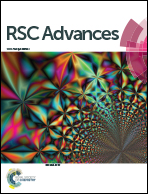Solvatochromic properties of 3,6-di-tert-butyl-8H-indolo[3,2,1-de]acridin-8-one†
Abstract
The spectral and photophysical properties of newly synthesized 3,6-di-tert-butyl-8H-indolo[3,2,1-de]acridin-8-one were studied. To determine the contribution of specific and nonspecific interactions of this compound with solvents, the solvatochromic methods were used. It was found that bathochromic shifts of absorption and fluorescence spectra were mostly caused by polarizability/dipolarity interactions of the solute with solvent. The excited state dipole moment, determined based on a solvatochromic method, is two times higher than that in the ground state. Also, the spectral and photophysical properties of the compound studied correlate with the ENT solvent polarity scale. The radiative rate constant does not depend on the solvent properties, while the non-radiative rate constant decreases with increasing solvent polarity. Such a decrease of the non-radiative rate constant with the lowering of the energy gap between the S0 and S1 states indicates the participation of the triplet state in the deactivation of the excited state. After photoexcitation hydrogen bond energy increases in both the locally excited Franck–Condon and the relaxed excited state, however, the change of hydrogen bond energy is three times higher in the relaxed excited state. The hydrogen bond energy change measured in five alcohols correlates with the Kamlet–Taft or Catalán solvent acidity parameter.
![Graphical abstract: Solvatochromic properties of 3,6-di-tert-butyl-8H-indolo[3,2,1-de]acridin-8-one](/en/Image/Get?imageInfo.ImageType=GA&imageInfo.ImageIdentifier.ManuscriptID=C4RA00787E&imageInfo.ImageIdentifier.Year=2014)

 Please wait while we load your content...
Please wait while we load your content...